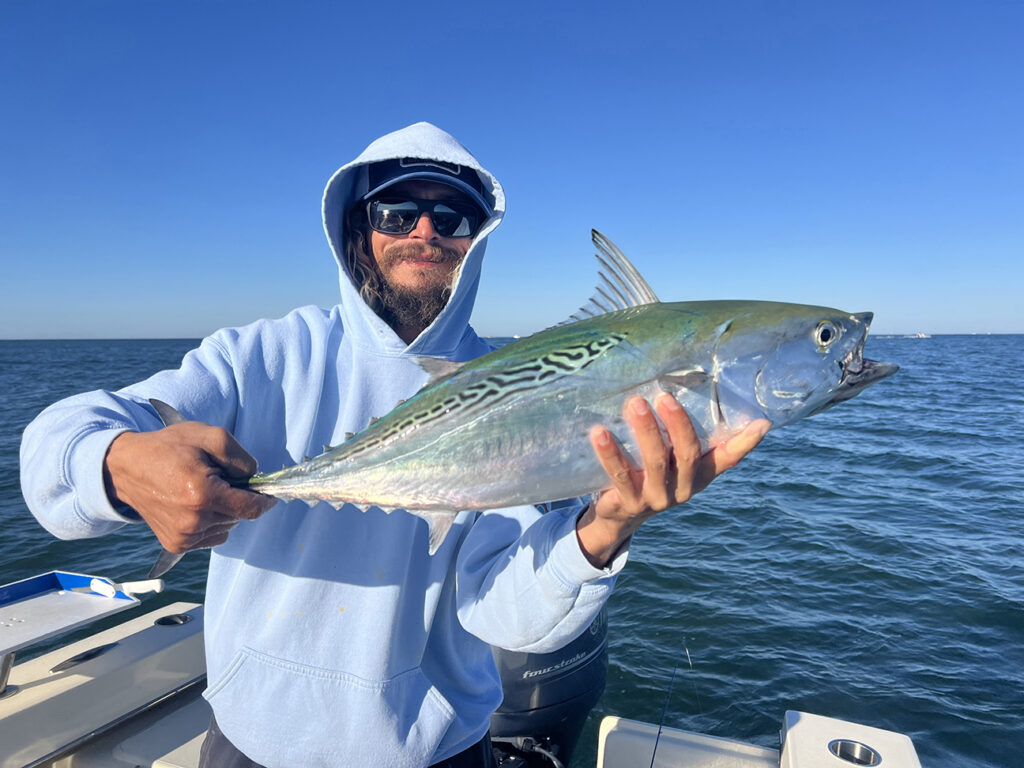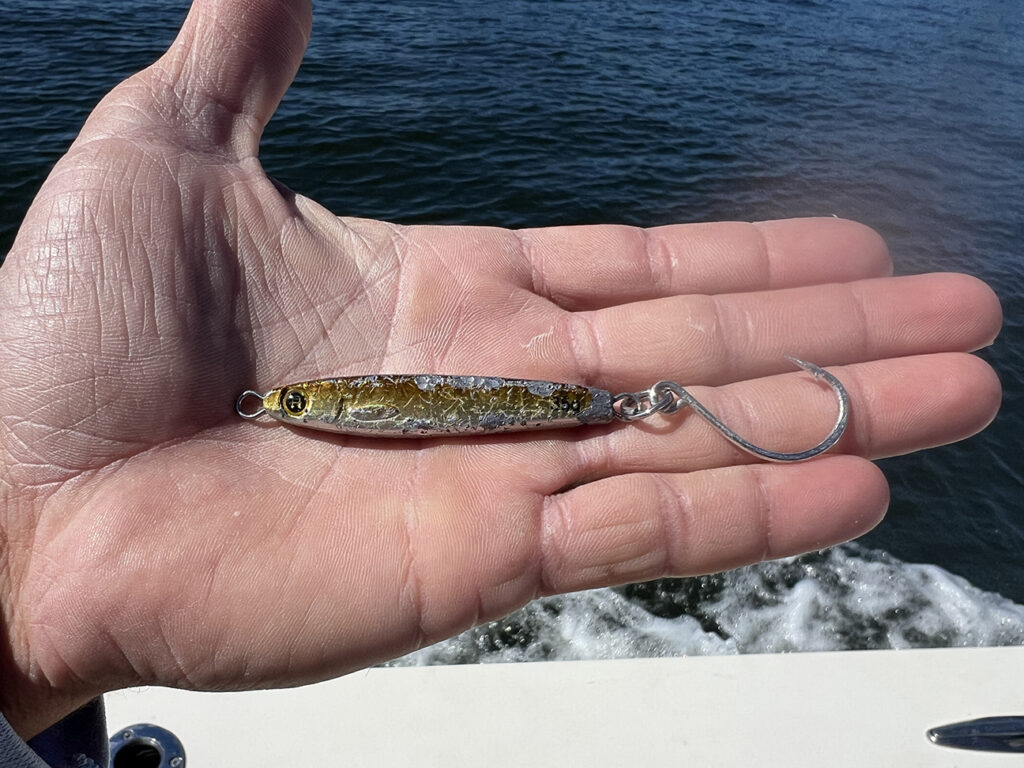Tidelines – November 2024
“Sometimes it’s true that the early bird gets the worm,” Capt. Travis Hudgins, of Drum Roll Charters out of the Morehead City area, said with a smile as we cruised closer to the Hook at Cape Lookout close to 9:00 am, “but the birds have to see what they are eating. The bite doesn’t really happen until the sun gets up.”
The “bite” he was referring to was the world-class false albacore fishery that Cape Lookout is known for and happens every fall, and for a guy that drove up from Wilmington that morning, a later start worked for me.
Several boats were drifting and looking when we arrived, but all were clearly waiting and not on any fish. Maybe 20 minutes went by, and no one in the fleet, including us, saw a fish. I know enough to look for birds, bait, and fish, but I don’t know what birds are more helpful in the search for albacore than other birds, so I asked.
“Pelicans this time of year are typically diving on shad, so chasing pelicans diving will usually just lead you to a bunch of shad,” he started. “I like the brown-faced seagulls and the terns. The brown-faced seagulls will get together in a tight knot and hover and pick. The terns, or the white birds with the orange beaks, do a lot of diving and picking, too, but the bulk of the false albacore are going to be underneath the brown gulls.”
Everything was still quiet, other than the Grateful Dead Pandora channel he had playing, so I asked about bait.
“These fish focus mostly on three types of bait,” Travis replied as he began idling away from the Hook and started back down the Shackleford beachfront. “Half beak ballyhoos that look like a giant silverside, regular silversides, and red anchovies. You can find a Stingsilver to match any of those three baits.”
The music and my little question and answer session were both just the right amount of background noise as we panned our surroundings looking for signs of life. The low wind and calm seas gave us plenty of vision.
“I feel like fish are definitely a creature of habit,” he answered, even though I hadn’t asked out loud how confident he was that we were in a good location for the fish to appear. “The conditions these last couple of days have been basically the same, so these fish are more than likely going to be in the same spot today but perhaps an hour later to allow for the difference in tides.”

Capt. Travis Hudgins, of Drum Roll Charters out of Morehead City, with a false albacore that fell for a Stingsilver. He was fishing just off the Shackleford Banks beachfront.
And like we were following the script of a movie, just then the irregular and frantic splashes of a small school of feeding false albacore surfaced about 100 yards down the coast.
Many of the boats around us had moved on in the direction of the shoals, but this was a pretty weather day in late October off Cape Lookout. We were the first on the school, but we weren’t alone.
Travis passed by the school and then approached the frenzy from the south.
“I like to get above the fish, upwind or up current,” he explained, “because typically these fish are feeding into the current, so when you’re bringing your bait through them, to them it’s like the bait is swimming away.”
I had in my hand a rod rigged with a smaller Stingsilver that was white with a silver stripe, and I asked Travis how he wanted me to work it.
“I always like to cast slightly past the school because that lets the jig hit the water, let’s the bubbles settle, and by the time you close your bail and start cranking it back, that jig is already a foot or two under the water. When you get that lure directly in the activity, that lure is fishing just as it should be,” he told me as I let the metal fly.
My first cast went over and then back through the feeding frenzy with no bites. My second and third cast did the same, but Travis came tight on his first cast. His rod bent over, line peeled out at a blistering pace, and we were no longer hunting albacore—we were catching albacore.
After photos and during the release, another small pod appeared in the distance. The three boats with us took off, but Travis wanted to hold tight.
“Just because the birds aren’t working or the baits not flipping or the fish aren’t feeding doesn’t mean that the bait and fish aren’t still there,” he said to me as I kept watching the feeding activity and terns way off our portside bow. “I’ll mark on the machine the bait that the false albacore are on, and if you stay on top of the bait and be patient, everyone else will scurry away to go look for something else, and then what you saw five minutes ago that brought you to that place, you’ll have all to yourself.”

Capt. Tyler Hudgins holds up a well-used Stingsilver that he re-hooked with a VMC specimen inline hook. The rollback eye keeps the eye in line with the hook and is specifically made to go on a split ring and be fished behind a lure.
Sure enough, in less than five minutes, another pod of fish surfaced within casting distance. I headed back to the bow, Travis made his cast from beside the console, and that’s how the rest of our morning went. At times we were patient, at times we gave in to the adrenaline-pumping run-and-gun, and we stayed on fish until lunchtime.
Capt. Travis Hudgins, of Drum Roll Charters, typically starts his search for false albacore in late August or early September, and the fish mostly cooperate well into November. If you miss the opportunity to chase false albacore with Travis this year, you can either get a date in the books for next year (October is his favorite month), or you can hop on board with him throughout the winter months to enjoy the great speckled trout action he puts clients on anywhere from the Neuse River to the White Oak River.
More information on Travis and Drum Roll Charters can be found at www.drumrollcharters.com or by calling (252) 725-5151.
How will you handle yourself on a false albacore trip with Travis. Will you be patient or will you give in to the run-and-gun? The beauty is, I don’t think there’s a wrong answer.
